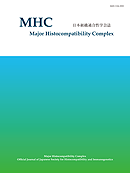
- Issue 2 Pages 77-
- |<
- <
- 1
- >
- >|
-
Taeko K Naruse2021 Volume 28 Issue 2 Pages 77-82
Published: 2021
Released on J-STAGE: August 11, 2021
JOURNAL FREE ACCESSThe HLA Technologist and Director Certification System for Histocompatibility Testing of the Japanese Society for Histocompatibility and Immunogenetics (JSHI) offers various programs and training opportunities for the members to be certified as the expert. Here we will make comment on difficult questions in the paper test to help your study.
View full abstractDownload PDF (1649K) -
Fumihiro Azuma2021 Volume 28 Issue 2 Pages 83-93
Published: 2021
Released on J-STAGE: August 11, 2021
JOURNAL FREE ACCESSHLA typing in donors and recipients is important because HLA compatibility has a significant impact on transplantation and platelet transfusion in HLA antibody-positive cases. In the past, serological tests were performed by the LCT method, but now DNA typing is mainstream. Currently, methods such as PCR-SSP, PCR-rSSO, PCR-SBT, and NGS-SBT are used in clinical laboratory and research fields. They have advantages and disadvantages in quickness, multi-sample processing capacity, resolution, cost, etc., and are selected according to the purpose. With the advent of commercially available DNA typing reagents, it has become easier to implement, but there are still issues in interpreting results, such as the divergence with serological results due to the null gene and ambiguity. HLA typing is a fundamental technology that is needed not only in transplantation and blood transfusion, but also in the fields of drug selection for cancer vaccines, disease association, drug adverse effects such as severe drug eruption, and infection protection, and is expected to become even more important in the future.
View full abstractDownload PDF (2319K) -
Hideki Ohdan2021 Volume 28 Issue 2 Pages 94-101
Published: 2021
Released on J-STAGE: August 11, 2021
JOURNAL FREE ACCESSIt is practicable to extract immunologically high-risk cases, which may be at risk of rejection or infection with uniform immunosuppressive therapy, on the basis of genomic information of immune function molecules, and to apply focused personalized immunosuppressive therapy by immune-monitoring. Therefore, we comprehensively analyzed the candidate gene polymorphisms of immune-related molecules associated with organ transplantation outcomes. Among them, we found that single nucleotide polymorphisms (SNPs) of FcγR genes FCGR2A (rs 1801274) [131 H/R] and FCGR3A (rs396991) [158 F/V] were significantly associated with the onset and causative organisms of sepsis in liver transplant recipients and urinary tract infection in kidney transplant recipients, and that SNP of FOXP 3 promoter region (rs3761547) [33499 A/G] was associated with sensitivity of liver transplant recipients to pulsed steroid therapy, which is used to treat acute rejection. We performed a mixed lymphocyte reaction assay using carboxyfluorescein diacetate succinimidyl ester (CFSE) cytoplasmic staining and multiparameter flow cytometry to minimize immunosuppressive therapy in the recipients with risk factors to optimize the dosage of immunosuppressive drugs by fine tuning based on immune-monitoring.
View full abstractDownload PDF (1788K)
-
Shingo Suzuki, Yoshie Kametani, Takashi Shiina2021 Volume 28 Issue 2 Pages 102-110
Published: 2021
Released on J-STAGE: August 11, 2021
JOURNAL FREE ACCESSThe HLA-G gene is classified as one of the non-classical HLA class I genes because of its low level of polymorphism, and its expression restricted to particular cell types. Although classified as non-classical, the HLA-G protein appears to play a role as an immune checkpoint molecule in pregnancy immunity, suppressing immune responses during organ transplantation, immune escape of tumors and viruses, and developing autoimmune diseases. The gene is known to be not highly polymorphic, but it has been recently reported that 14 bp insertion/deletion polymorphism (rs66554220) and one SNP (rs1063320) located in the 3’UTR of the HLA-G gene are associated with the risk of acute graft versus host disease and overall survival. We report here the determination of 22 full-length HLA-G allele sequences in the Japanese population, including the regions such as 3’UTR that are absent from the allele sequences released from the IPD-IMGT/HLA database.
View full abstractDownload PDF (1346K)
- |<
- <
- 1
- >
- >|